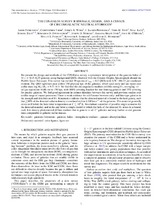| dc.contributor.author | Tumlinson, Jason | |
| dc.contributor.author | Thom, Christopher | |
| dc.contributor.author | Dave, Romeel | |
| dc.contributor.author | Werk, Jessica K. | |
| dc.contributor.author | Prochaska, J. Xavier | |
| dc.contributor.author | Tripp, Todd M. | |
| dc.contributor.author | Katz, Neal | |
| dc.contributor.author | Oppenheimer, Benjamin D. | |
| dc.contributor.author | Meiring, Joseph D. | |
| dc.contributor.author | Ford, Amanda Brady | |
| dc.contributor.author | O'Meara, John M. | |
| dc.contributor.author | Peeples, Molly S. | |
| dc.contributor.author | Sembach, Kenneth R. | |
| dc.contributor.author | Weinberg, David H. | |
| dc.date.accessioned | 2017-07-24T08:52:57Z | |
| dc.date.available | 2017-07-24T08:52:57Z | |
| dc.date.issued | 2013 | |
| dc.identifier.citation | Tumlinson, J. et al. (2013). The COS-Halos survey: Rationale, design and a census of circumgalactic neutral hydrogen. The Astrophysical Journal , 777 (59): 1-33 | en_US |
| dc.identifier.issn | 0004-637x | |
| dc.identifier.uri | http://hdl.handle.net/10566/3098 | |
| dc.description.abstract | We present the design and methods of the COS-Halos survey, a systematic investigation of the gaseous halos of
44 z = 0.15–0.35 galaxies using background QSOs observed with the Cosmic Origins Spectrograph aboard the
Hubble Space Telescope. This survey has yielded 39 spectra of zem 0.5 QSOs with S/N ∼10–15 per resolution
element. The QSO sightlines pass within 150 physical kpc of the galaxies, which span early and late types over
stellar mass logM∗/M = 9.5–11.5. We find that the circumgalactic medium exhibits strong Hi, averaging 1Å
in Lyα equivalent width out to 150 kpc, with 100% covering fraction for star-forming galaxies and 75% covering
for passive galaxies. We find good agreement in column densities between this survey and previous studies over
similar range of impact parameter. There is weak evidence for a difference between early- and late-type galaxies in
the strength and distribution of Hi. Kinematics indicate that the detected material is bound to the host galaxy, such
that 90% of the detected column density is confined within ±200 km s−1 of the galaxies. This material generally
exists well below the halo virial temperatures at T 105 K. We evaluate a number of possible origin scenarios for
the detected material, and in the end favor a simple model in which the bulk of the detected Hi arises in a bound,
cool, low-density photoionized diffuse medium that is generic to all L
∗ galaxies and may harbor a total gaseous
mass comparable to galactic stellar masses. | en_US |
| dc.language.iso | en | en_US |
| dc.publisher | IOP Publishing | en_US |
| dc.rights | Publisher retains copyright. Authors may archive the published version in their institutional repository. | |
| dc.source.uri | http://dx.doi.org/10.1088/0004-637X/777/1/59 | |
| dc.subject | Galaxies | en_US |
| dc.subject | Formation – galaxies | en_US |
| dc.subject | Halos – intergalactic medium – quasars | en_US |
| dc.subject | Absorption lines | en_US |
| dc.title | The COS-Halos survey: Rationale, design and a census of circumgalactic neutral hydrogen | en_US |
| dc.type | Article | en_US |
| dc.description.accreditation | Department of HE and Training approved list | |

